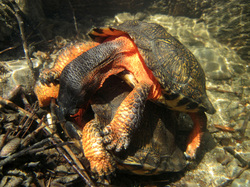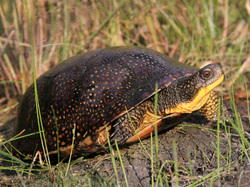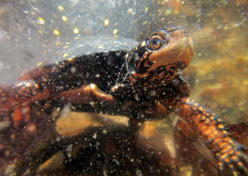Conservation Planning and Implementation
|
Many freshwater turtle species have complex habitat requirements, requiring large and diverse mosaics of upland, wetland, and aquatic habitats with high ecological integrity. As a consequence of this as well as their individual longevity (many decades) and marked fidelity to certain landscape features (often using the same sites year after year for nesting or overwintering), turtles often fall through the cracks when standard “coarse filter” metrics are applied to land conservation prioritization. As an example of this, the U.S. National Parks and other federal lands in the United States and Canada disproportionately protect habitat that is unsuitable for turtles. Therefore, it is necessary that some turtle species continue to be protected using a fine-filter approach, specifically tailored to their unique life history characteristics and habitat needs. Because of their habitat requirements and localized distributions, their conservation requires coordination among many partners and an on-the-ground sampling effort. To accomplish this, we work with partner organizations to evaluate status and develop broad-scale conservation planning strategies for species of regional conservation concern.
We assist in the conservation planning throughout the process, from early-stage capacity building through planning, implementation, and follow-up: Capacity Building and Partnerships Conservation Planning and Site Prioritization Implementation of Conservation Recommendations Technical Assistance, Outreach, and Follow-up |
We play a coordinating role in three regional projects:
 Wood Turtle Status Assessment (DRAFT) Wood Turtle Status Assessment (DRAFT)
1. Regional Conservation Planning: Wood Turtles in the Northeast.--We are part of a 13-state coalition, the Northeast Wood Turtle Working Group, which focuses on the continued survival of the North American wood turtle (Glyptemys insculpta) in the streams, fields, and forests of the northeastern Unites States and eastern Canada. In 2010, with State Wildlife Grant (SWG) funds from Northeast Association of Wildlife Agencies, the WTWG launched a two-year effort to evaluate the status of the species in the region. As an ongoing partner to this effort, we maintain twelve long-term wood turtle reference sites ("observatories") in Maine, New Hampshire, and Massachusetts, a network now in its eleventh year. This project is a partnership between the state agencies of the Northeast Region, UMass Amherst, the Massachusetts Coop Unit, and the Smithsonian Conservation Biology Institute.
 Blanding's Turtle Conservation Plan (DRAFT) Blanding's Turtle Conservation Plan (DRAFT)
2. Regional Conservation Planning: Blanding's Turtle in the Northeast.--We are part of the Northeast Blanding’s turtle working group (NEBTWG), a team of scientists, land managers, and other interested parties in five states focused on the conservation of the isolated populations of Blanding’s turtle in the northeastern United States. With funding from the U.S. Fish and Wildlife Service’s Competitive State Wildlife Grants program, NEBTWG is currently developing a regional conservation plan for the species by conducting region-wide, standardized monitoring, prioritizing sites, and working with land trusts to secure and manage habitat for Blanding’s turtle. As part of this effort, we study and monitor two large population complexes in New Hampshire and Massachusetts.

3. Capacity Building for Spotted Turtle Conservation Planning.--The spotted turtle is a species of conservation interest throughout the Northeast and is considered "endangered" by the IUCN. As an early step toward regional coordination, which would help to identify the most functional and important landscapes for spotted turtles in the Northeast, we are working with partners including SCBI, UMass, MassWildlife, and Maine Inland Fisheries and Wildlife to test and develop survey protocols, develop and sustain long-term monitoring sites in priority landscapes, and build on partnerships developed through conservation planning for other turtle species.
|